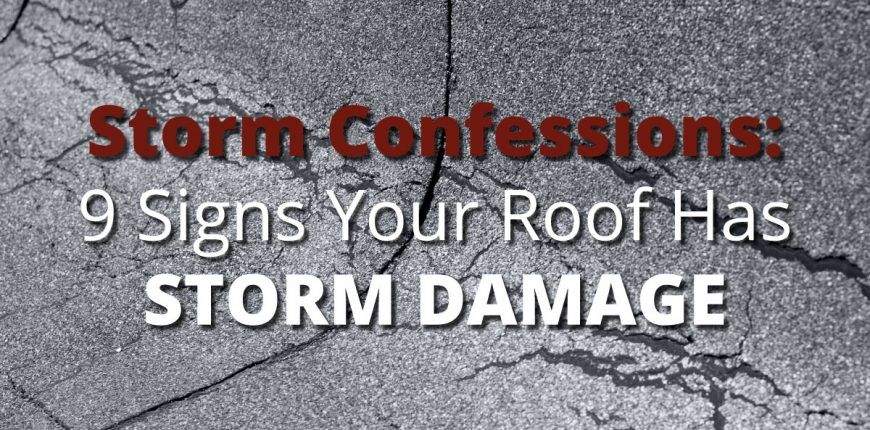
Sometimes the condition of your home’s roof becomes compromised because of things out of your control – like the weather, for instance. New Hampshire’s otherwise beautiful climate can produce volatile weather, which may damage roofs. Those storms include high wind, hail, and rain, all of which may require some roof repair once they’ve passed.
Speaking of high winds, meteorologists at New Hampshire’s Mount Washington Observatory recorded wind gusts of 148 mph in February, the strongest in over a decade. Meanwhile, heavy rain and hail can damage your shingles – extensively when the pieces of hail are larger than usual. How will you know if your roof is damaged by wind, hail, and rain? Here are some clues.
Storm Damage You Can See From the Ground
You don’t always have to be on your roof to see storm damage. It’s always a good idea after a storm to inspect your roof from the ground and look for the following signs of damage.
- Collection of shingle granules – Asphalt shingles have granules to protect them from UV rays while making them more resistant. If you see an abundance of these granules in your yard and landscaping, then your roof has sustained storm damage.
- Leaky & Clogged Gutters – Leaking and clogged gutters often indicate roof storm damage and can result in negative consequences for your home and roof. Your roof will begin to leak for one, while mold and water damage may also accumulate. They can even cause damage to your home’s foundation because accumulated water can’t drain properly. The bottom line is that clogged gutters can easily cause severe roof damage over time.
- Property damage – If vehicles and other types of property show signs of damage, there’s a good chance your roof has also sustained storm damage.
- Broken, cracked, and missing shingles – You should be able to notice damaged shingles from the ground. Check for missing and damaged shingles, including curled, cracked, or torn shingles. Wood shingles may show signs of splitting, curling, or decay, while flat roofs may have cracks, tears, wrinkles, and blisters. You may even notice shingles on the ground when a storm is particularly fierce.
Signs of Storm Damage Inside the Home
Storm damage to your roof may also become evident inside your home.
- Water damage on walls and ceilings – Some signs of water damage are easy to spot within the house, while others aren’t so easy. Visible signs include dark or wet spots on the wall or ceiling, drywall that’s flaking or cracking, and wet spots around pipes, toilets, sinks, and taps. You may also notice a musty or moldy smell or even a sewage smell coming from plumbing fixtures. Wet flooring is another sign and may go unnoticed if it occurs in rooms you don’t use as frequently.
- Problems in the attic – Your home’s attic is another area to inspect after a storm hits. If you notice water accumulation in the attic, including drips or stains on the underside of the roof or sheathing, or wet insulation, there’s a good chance the storm caused it. Damp and wet framing in the attic is another indicator of storm damage. Just make sure the leaks in your attic aren’t caused by plumbing which may run through it.
What are the signs of storm damage your roofer will see?
We never advise going up on your roof after a storm. Leave that up to a professional – a knowledgeable contractor who will inspect for further damage you can’t see from the ground.
- Deeper Damage – Your roofer will check for damage to the layers underneath the shingles, including the underlayment. The underlayment provides a temporary barrier against rain and wind. They’ll also check the decking (typically made from plywood or oriented strand board, but also from other materials such as metal). The decking is attached to the rafters to create the foundation of the roofing system.
- Gutters – Heavy storms may also damage the roof’s drip edge, which prevents water from building up while guiding it over the eaves and into the gutters. For this reason, your gutters should also be inspected for leaking seams, bending or sagging, as well as missing sections of the gutter system.
- Hiding Damage – The roofer will also assess the overall extent of missing shingles beyond what you can see from the ground level. Flying debris from branches, hail, and severe rain – all can destroy shingles and pull them from the roof. Another sign of storm damage is loose or missing flashing near chimneys.
In any case, schedule an appointment with your roofing contractor as soon as possible after the storm so that they can assess the damage.
Call J. Carnes & Son Roofing when your roof experience storm damage. The professionals at J. Carnes offer superior workmanship and the highest-quality customer service.




